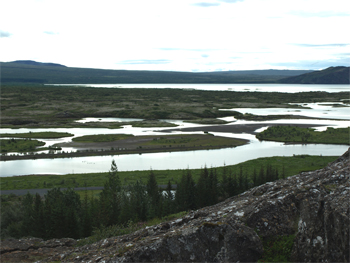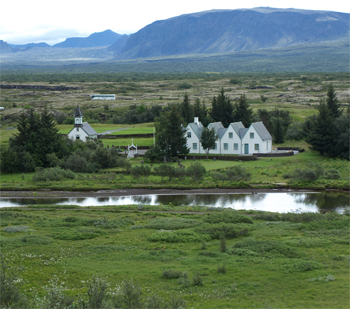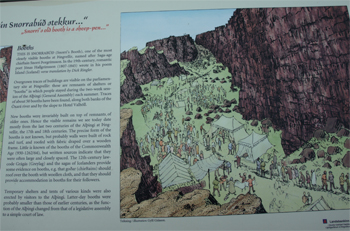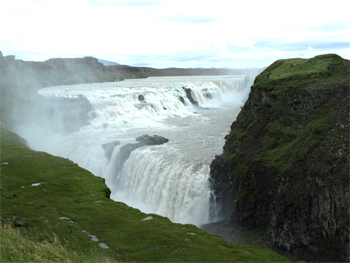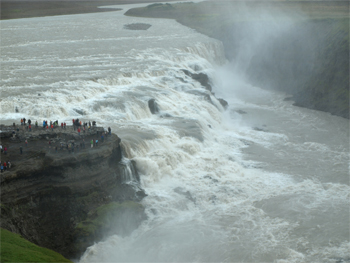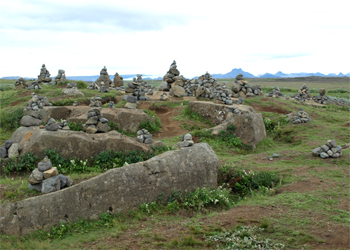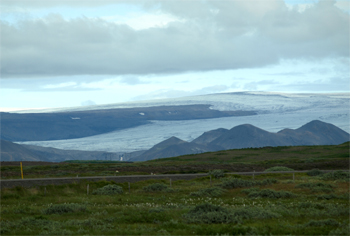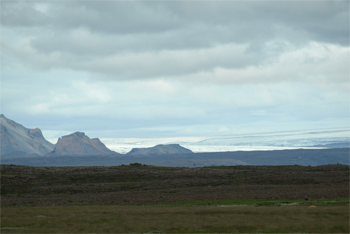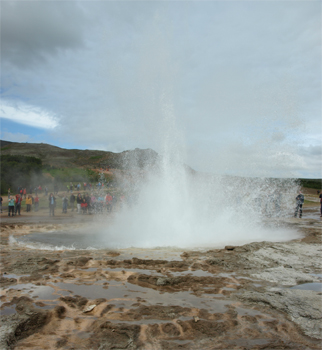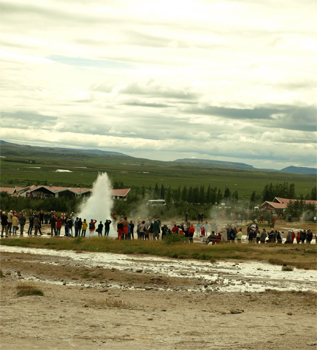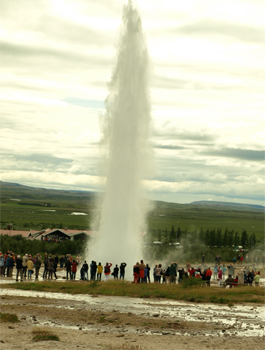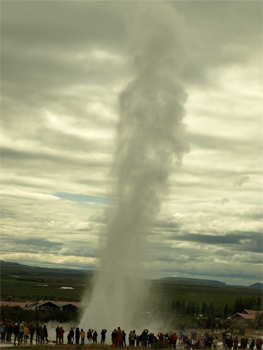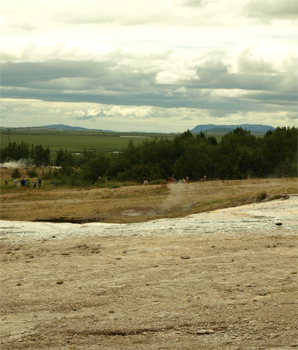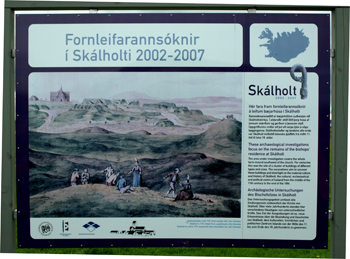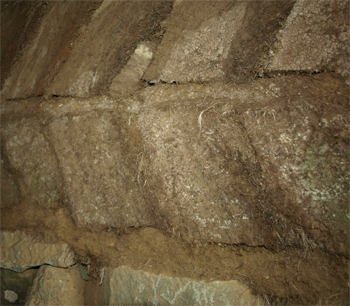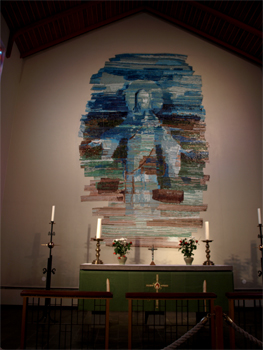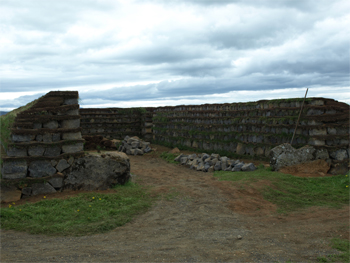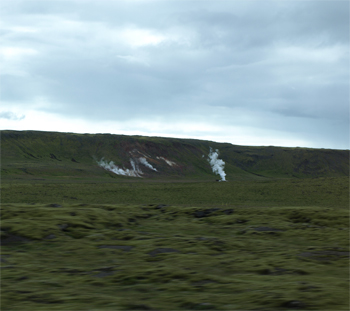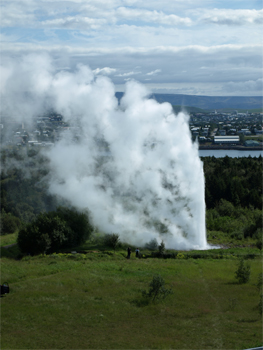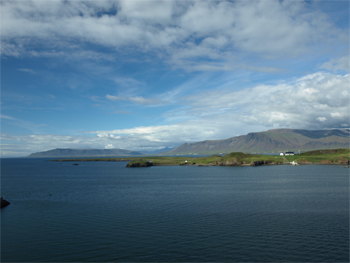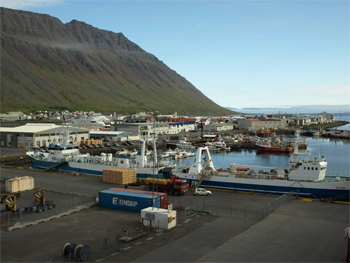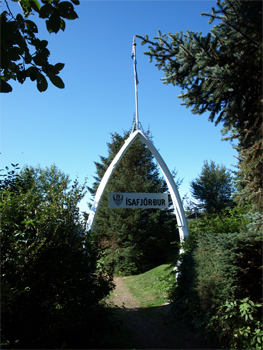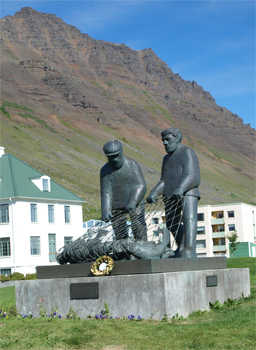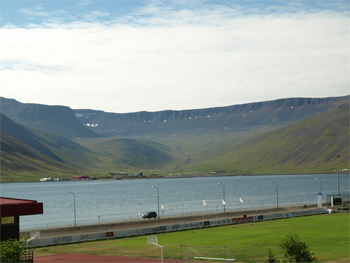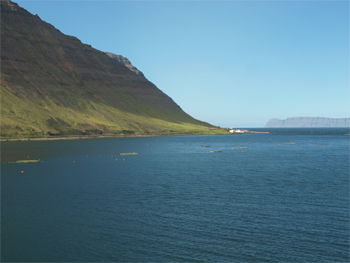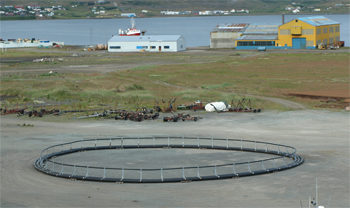Fri., 7/30/10 - Reykjavik, Iceland
We were up early this morning (our time zone change gave us an extra hour of sleep) to take our excursion tour to Thingvellir, Gullfoss, and Geysir which are inland from Reykjavik.
Our motor coach took us first to Thingvellir National Park, where the geological fault (known as Almannagja) between the European and North American tectonic plates is separating at the rate of about one inch a year.
Icelandic License Plate |
Thingvellir National Park
|
Thingvellir National Park - Thingvellir Church
|
Thingvellir National Park |
|
We walked to the place where Europe's oldest national legislative assembly (the Icelandic Althing) took place from 930 AD into the early 18th century. The four regions of Icelandic settlements met here each summer. The legislative powers met to amend or add laws to rule the land and they read out the existing laws to all the citizens who gathered there. The judicial group met here at the same time and handled disputes that could not be settled within the regions. This meeting time had a festive atmosphere. It sounds like one of America's Indian powwows. It was a very interesting site.
|
Thingvellir National Park - Almannagja fault between the European and North American tectonic plates |
Thingvellir National Park - Almannagja fault between the European and North American tectonic plates
|
Back on the bus, we headed across the magnificent landscape - heaths, rugged volcanic peaks, and lava rocks - to the Gullfoss waterfalls. We could see two huge glaciers in the distance, which formed this mighty river.
Gullfoss Falls
|
Gullfoss Falls |
Gullfoss Falls
|
Someone liked building cairns above the falls |
Langjokull Glacier
|
Hofsjokull Glacier |
The next stop was to wander around the Geysir geothermal area and watch Strokkur spout. It was not unlike Old Faithful – only it went off much more frequently. There were other boiling pots and open steam vents to look at. We ate lunch at the Geysir Hotel.
|
Strokkur getting ready to blow
|
Strokkur beginning to blow
|
Strokkur performing for its audience |
Strokkur performing for its audience
|
Strokkur performing for its audience - Impressive! |
Hot pool |
|
|
All that is left of the mighty Geysir
|
On the way back to Reykjavik we stopped at the historic site at Skalholt. In the 11th century the South Iceland bishop built his house, church, and Latin school here. The two-foot high stone foundations give an idea of the layout of the original structures. The school prepared boys to become Evangelical Lutheran preachers. A new church stands nearby and the stone crypts in the basement date back to the 11th century.
Skalholt |
Original turf walls
|
Skalholt Cathedral |
Cathedral interior - very plain Lutheran
|
Excavation |
There are so many geothermal areas venting steam all across the island, that the steam and hot water are captured to heat homes and to power turbines to create electricity. These vents were seen from our bus and we motored back to Reykjavik.
|
In Reykjavik we stopped to view the panorama of the capital city from an observation deck/revolving restaurant called The Pearl - a glass dome built above four huge cylindrical hot water tanks. We were near the airstrip the Brits started to build and the US military completed during WWII. The Hallgrimskirkja (Lutheran Church of Iceland), which looks like a space shuttle ready to take off, was easy to see. Reykjavik is an interesting city with very few buildings over four or five stories because of the many earthquakes that occur here.
Reykjavik - the modern (and unusual) Hallgrimskirkja is in the center of the picture
|
Reykjavik |
"Fake" geyser on the grounds of "The Pearl"
|
Land and water west of Reykjavik |
"Permanently docked" (according to one local) Russian trawlers - even though the Cold War is looooong over
|
Iceland was created by volcanoes and earthquakes along very obvious fault lines. Moss eventually (1,000 years) grows over the lava rocks and gives the hills and cliffs a green appearance. Since volcanic ash has sharp glass-like edges, vegetation takes a while to grow on it. To speed the process, a plant called "lupina" is seeded on the ash and it fertilizes and softens the top layer of soil so other things can grow.
|
After dinner I went to the evening entertainment. Three local musicians/dancers gave a wonderful, light-hearted talent show with piano, guitar, and singing. The ancient Icelandic and Viking songs were interesting.
Sat., 7/31/10 - Isafjordur, Iceland
This morning we docked at a small fishing town, Isafjordur. We took our visitor maps and struck out to walk the town. It is a neat, clean town at the end of a fjord and is large enough to have a hospital, community gymnasium, and two soccer fields.
Isafjordur harbor |
Steep hills above Isafjordur
|
Fishing net floats
|
Auto dealership? |
Typical Scandinavian troll - everyone has one
|
Whale bone welcome arch |
Typical sign - the language is impossible to decipher |
Statue honoring the fishermen
|
We visited the Maritime/Heritage museum. Some young people gave folk dancing demonstrations. We were interested in the fishing equipment and display. Dried and salted cod was a big industry here before refrigeration. The men caught the fish and the women dried and salted them. It was a lengthy process. The young boys learned to sew their own fishing parkas and pants and rubbed them with the liver of codfish to waterproof them, therefore, "oil-skins." The museum had samples of dried herring, some edible kelp and the local fermented drink. We passed on the samples! A part of the museum displayed accordions of vintage design. This was the old folk instrument and a large part of Icelandic heritage.
|
|
Accordions in the Maritime Museum |
View of the surrounding landscape
|
Salmon farming in the fjord
|
Salmon ring and net used to keep the farmed salmon together so they can first grow and then be harvested |
It was also interesting to learn that early settlers in Iceland were able to add beach plants and seaweeds to their diet of fish, seal, and whale. The plants were high in vitamin C and prevented scurvy.
We went up to the 13th deck for the "sail-away." The fjords are surrounded by the volcanic (basalt) cliffs and those facing north still have snowfields. Today was the first we have seen snow other than on glaciers.
| Return to Top | Return to Itinerary | Return to Dreamcatcher Home Page |

